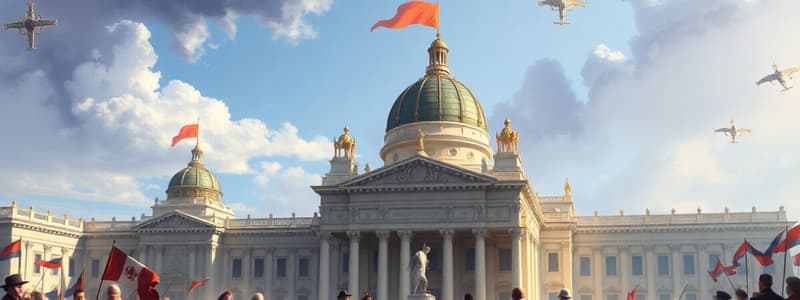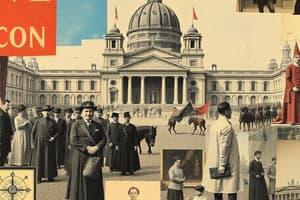Podcast
Questions and Answers
What was the primary focus of the Congress of Vienna?
What was the primary focus of the Congress of Vienna?
- Creating a unified European government
- Establishing trade agreements
- Reestablishing monarchies in Europe (correct)
- Promoting democratic ideals
The Holy Alliance was comprised of countries that supported revolutionary ideas.
The Holy Alliance was comprised of countries that supported revolutionary ideas.
False (B)
Who prompeted the Spanish Revolution of 1820?
Who prompeted the Spanish Revolution of 1820?
Military units under King Ferdinand VII
The _______ was a secret society founded in 1814 aimed at the Greek struggle for independence.
The _______ was a secret society founded in 1814 aimed at the Greek struggle for independence.
Match the following historical events with their corresponding years:
Match the following historical events with their corresponding years:
What was a common goal of the Italian revolutions in 1820-1821?
What was a common goal of the Italian revolutions in 1820-1821?
The principles of the French Revolution became less influential in Europe following the Congress of Vienna.
The principles of the French Revolution became less influential in Europe following the Congress of Vienna.
Name one of the founders of the Friendly Society.
Name one of the founders of the Friendly Society.
The Italian revolutions were primarily driven by members of the _______.
The Italian revolutions were primarily driven by members of the _______.
What was a key outcome of the Spanish Revolution by the end of 1823?
What was a key outcome of the Spanish Revolution by the end of 1823?
What was the primary aim of the Filiki Eteria?
What was the primary aim of the Filiki Eteria?
The leadership of the Filiki Eteria was successfully taken by Ioannis Kapodistrias.
The leadership of the Filiki Eteria was successfully taken by Ioannis Kapodistrias.
What strategy did the Filiki Eteria use to communicate among their members?
What strategy did the Filiki Eteria use to communicate among their members?
Women were accepted in the Filiki Eteria only by ___________.
Women were accepted in the Filiki Eteria only by ___________.
Match the following figures with their roles in the Filiki Eteria:
Match the following figures with their roles in the Filiki Eteria:
Why did the Filiki Eteria initially focus on wealthy Greek merchants?
Why did the Filiki Eteria initially focus on wealthy Greek merchants?
The Filiki Eteria found it easy to gain support from various social groups at first.
The Filiki Eteria found it easy to gain support from various social groups at first.
In which geographical area did the Greek Revolution decide to start?
In which geographical area did the Greek Revolution decide to start?
The Filiki Eteria was influenced by the ideas of the _____________ Revolution.
The Filiki Eteria was influenced by the ideas of the _____________ Revolution.
What was a punishment for violations within the Filiki Eteria?
What was a punishment for violations within the Filiki Eteria?
On what date did Alexandros Ypsilantis declare the revolution in Iasi?
On what date did Alexandros Ypsilantis declare the revolution in Iasi?
The Tsar supported the revolution led by Alexandros Ypsilantis.
The Tsar supported the revolution led by Alexandros Ypsilantis.
Who was considered a traitor and executed under the orders of the Friendly Society?
Who was considered a traitor and executed under the orders of the Friendly Society?
The critical battle took place in __________ on June 7, 1821.
The critical battle took place in __________ on June 7, 1821.
Match the following individuals with their roles in the revolution:
Match the following individuals with their roles in the revolution:
What hindered the recruitment for the revolution in the principalities?
What hindered the recruitment for the revolution in the principalities?
The mountainous terrains of the Peloponnese facilitated guerrilla warfare.
The mountainous terrains of the Peloponnese facilitated guerrilla warfare.
What was the name of the volunteer unit that distinguished itself in battle during the revolution?
What was the name of the volunteer unit that distinguished itself in battle during the revolution?
The Turkish army was preoccupied with the war against __________, allowing Greek forces to regroup.
The Turkish army was preoccupied with the war against __________, allowing Greek forces to regroup.
What happened to Alexandros Ypsilantis after he crossed the Austrian border?
What happened to Alexandros Ypsilantis after he crossed the Austrian border?
Flashcards
Congress of Vienna
Congress of Vienna
A meeting of European leaders (1814-1815) to redraw borders and restore order after Napoleon's defeat.
Holy Alliance
Holy Alliance
An alliance formed by Russia, Prussia, and Austria to suppress revolutionary ideas and restore absolute monarchies.
Restoration Era
Restoration Era
The period (1815-1830) following the Congress of Vienna when old regimes were re-established.
Greek War of Independence
Greek War of Independence
Signup and view all the flashcards
Spanish Revolution (1820)
Spanish Revolution (1820)
Signup and view all the flashcards
Italian Revolutions (1820-1821)
Italian Revolutions (1820-1821)
Signup and view all the flashcards
Carbonari
Carbonari
Signup and view all the flashcards
Philhellenes
Philhellenes
Signup and view all the flashcards
Philhellenic Society
Philhellenic Society
Signup and view all the flashcards
Principles of French Revolution
Principles of French Revolution
Signup and view all the flashcards
The Philhellenic Society's challenges
The Philhellenic Society's challenges
Signup and view all the flashcards
Philhellenic Society's target audience
Philhellenic Society's target audience
Signup and view all the flashcards
Philhellenic Society membership conditions
Philhellenic Society membership conditions
Signup and view all the flashcards
Philhellenic Society leadership
Philhellenic Society leadership
Signup and view all the flashcards
Greek Revolution starting point
Greek Revolution starting point
Signup and view all the flashcards
Reasons for the Greek Revolution
Reasons for the Greek Revolution
Signup and view all the flashcards
Danubian Principalities
Danubian Principalities
Signup and view all the flashcards
Factors aiding the Revolution
Factors aiding the Revolution
Signup and view all the flashcards
Obstacles to success
Obstacles to success
Signup and view all the flashcards
Communication in the Society
Communication in the Society
Signup and view all the flashcards
Φιλική Εταιρία
Φιλική Εταιρία
Signup and view all the flashcards
Αλέξανδρος Υψηλάντης
Αλέξανδρος Υψηλάντης
Signup and view all the flashcards
Why did the Greek Revolution start in Moldavia?
Why did the Greek Revolution start in Moldavia?
Signup and view all the flashcards
Ιερός Λόχος
Ιερός Λόχος
Signup and view all the flashcards
Why did the Tsar of Russia disavow the Greek Revolution?
Why did the Tsar of Russia disavow the Greek Revolution?
Signup and view all the flashcards
What were the advantages for the Greeks in the Peloponnese?
What were the advantages for the Greeks in the Peloponnese?
Signup and view all the flashcards
Κλέφτες
Κλέφτες
Signup and view all the flashcards
What role did Greek merchant ships play in the Greek War of Independence?
What role did Greek merchant ships play in the Greek War of Independence?
Signup and view all the flashcards
What was the outcome of the battle at Dragatsani?
What was the outcome of the battle at Dragatsani?
Signup and view all the flashcards
What happened to the Greek rebels in the monastery of Seccu?
What happened to the Greek rebels in the monastery of Seccu?
Signup and view all the flashcards
Study Notes
Congress of Vienna
- Convened by the victors of Napoleon (September 1814 – June 1815)
- Main objective: redrawing borders to maintain stability, restoring absolutism, and suppressing revolutionary ideals
- France's monarchy was reestablished, and its borders returned to 1789 levels.
Holy Alliance
- Formed by Russia, Prussia, and Austria in November 1815.
- Represented the forces of absolutism and counter-revolution.
- Restored deposed rulers to their thrones.
- The subsequent period (1815-1830) was known as the Restoration era.
Impact of the French Revolution
- Despite the attempt to reinstate pre-revolutionary order, the ideals of the French Revolution (liberty, equality, national self-determination) gained significant traction across Europe.
Spanish Revolution (1820)
- Military units rebelled against the authoritarian King Ferdinand VII, demanding the reinstatement of the 1812 constitution.
- The rebellion lasted until 1823 when suppressing force from the Holy Alliance ended the uprising.
- This incident sparked further revolutionary movements in Latin America.
Italian Revolutions (1820-1821)
- Occurred under Carbonari (members of a secret Italian society).
- Began in the kingdoms of Naples and Sicily in 1820.
- Aimed to overthrow Austrian dominance and achieve national liberation and constitutional reforms.
- Austrian forces, acting on Holy Alliance orders, quelled the revolts in 1821.
Philhellenic Society
- Founded in Odessa, Russia, in 1814.
- Aimed to prepare a Greek uprising for independence.
- Key figures included Nikolaos Skoufas, Athanasios Tsakalov, Emmanuel Xanthos, and Panagiotis Anagnostopoulos.
Greek War of Independence
- The society faced challenges in organizing and motivating participation across diverse Greek groups with differing interests.
Beginning of Greek Revolution
- The movement planned to launch the revolution in the Danubian Principalities (modern Romania).
- The plan selected these areas due to the absence of Ottoman forces and believed presence of Russian support.
- Alexander Ypsilanti crossed the Prut River on February 24, 1821, initiating the revolt in Iasi, Wallachia.
Challenges and Early Setbacks
- Initially, wealthy Greeks in the area did not sufficiently support the campaign.
- Russia disapproved and allowed Ottoman armies to quell the revolution.
- The Patriarch Gregory V excommunicated participants.
- A prominent figure, Vlad Dimitriev-Vlachos, was executed.
- Despite setbacks, Alexander Ypsilanti continued the fight leading to a decisive battle at Dragazani.
Further Greek Struggle
- Alexander's exile in Austria marked a tragic end to early revolution efforts.
- Further resistance led by important figures like Yorgakis Olympios and Ioannis Farmakis saw tragedy and defeat as Ypsilanti was captured.
Greek Revolution Success
- The revolution established strongholds in the Peloponnese, mainland Greece, and some Aegean islands.
- Greek fighters were led by local commanders, without centralized leadership.
Key Revolutionary Figures
- Prominent military figures included Theodoros Kolokotronis, Georgios Karaiskakis, Odysseas Androutsos, and Markos Botsaris on the land, and Konstantinos Kanaris and Andreas Miaoulis at sea.
- Notable women leaders included Lascarina Bouboulina and Manto Mavrogenous.
Studying That Suits You
Use AI to generate personalized quizzes and flashcards to suit your learning preferences.





